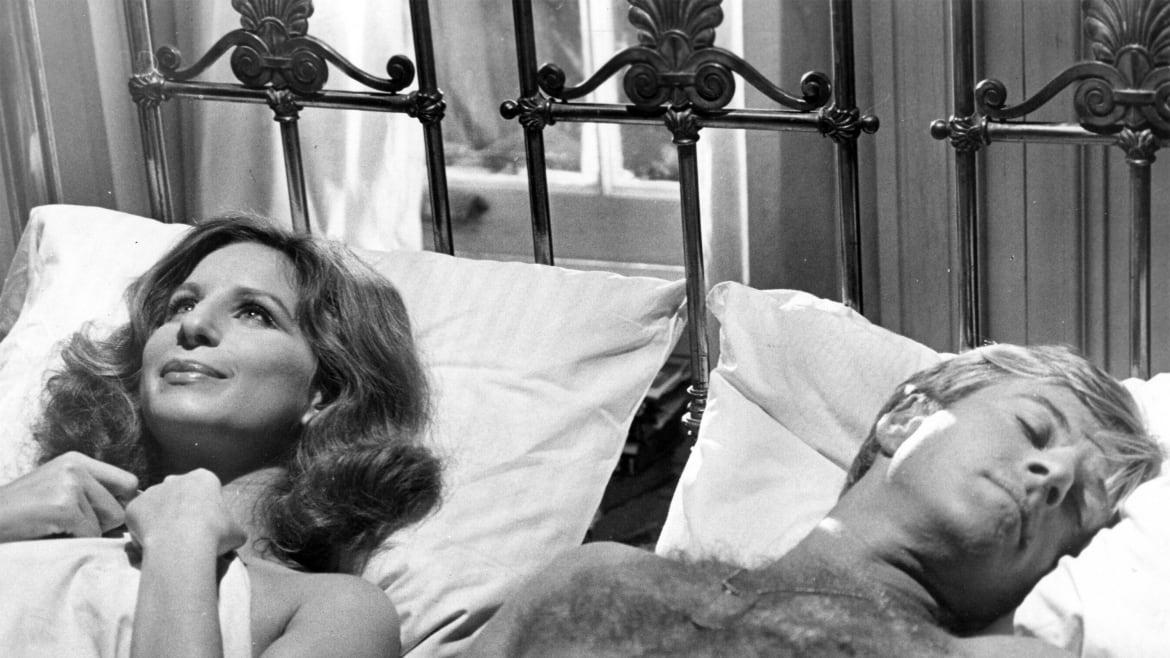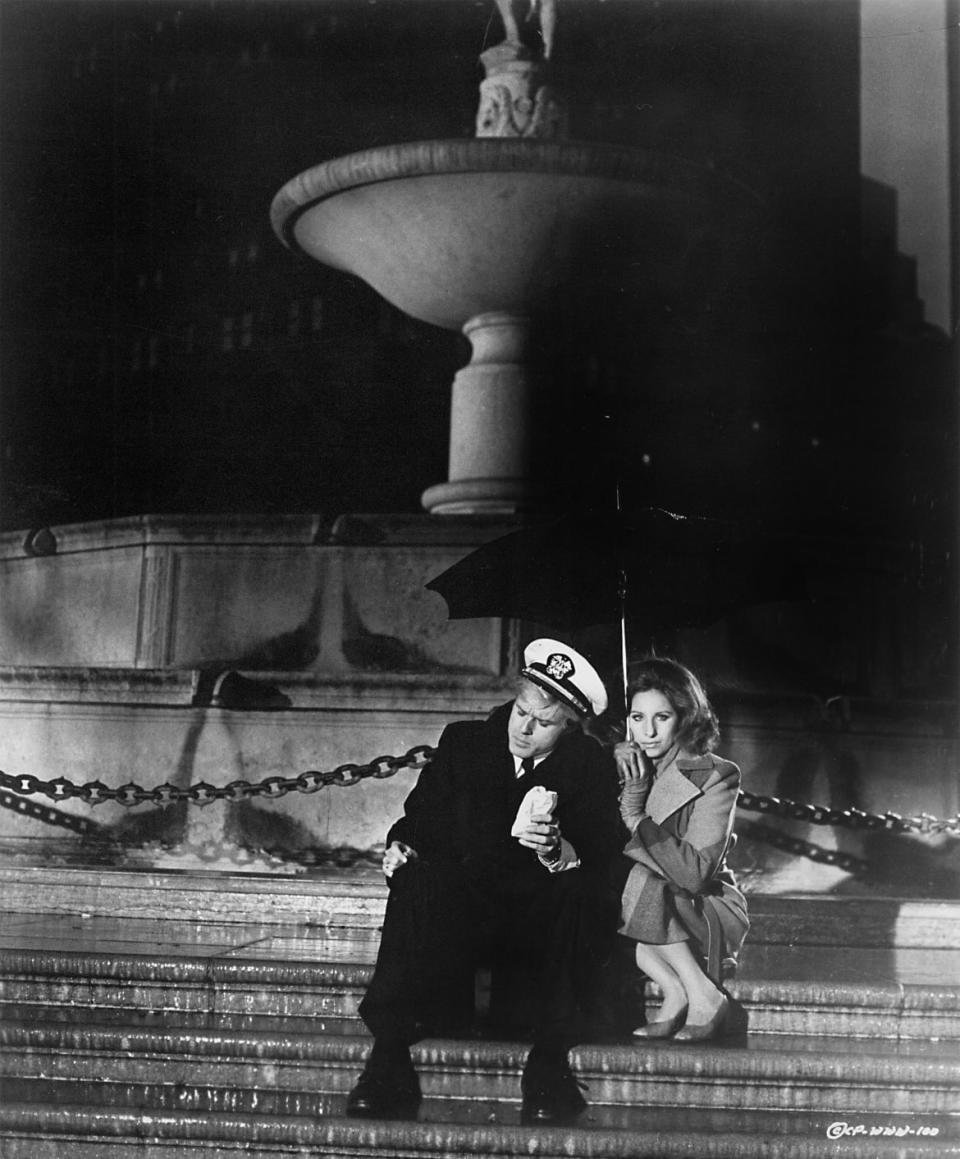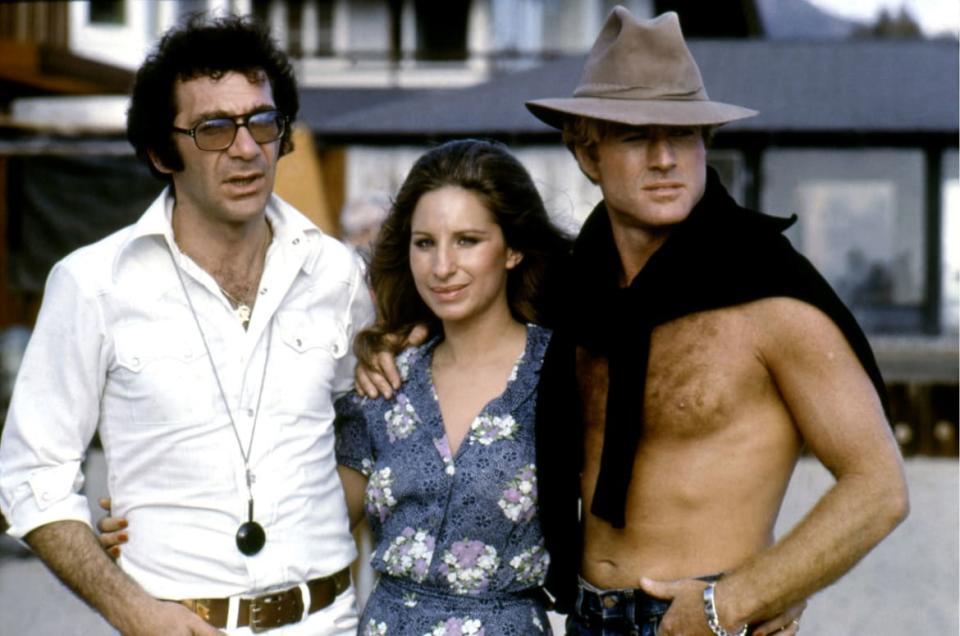The ‘Robert Redford’s Never Bad in Bed’ School of Filmmaking

- Oops!Something went wrong.Please try again later.
- Oops!Something went wrong.Please try again later.
- Oops!Something went wrong.Please try again later.
- Oops!Something went wrong.Please try again later.
- Oops!Something went wrong.Please try again later.
- Oops!Something went wrong.Please try again later.
Much anticipated for Barbra Streisand was her first love scene with Robert Redford in the film The Way We Were. “Streisand was a star who reportedly had had affairs with many of her leading men,” said one member of the production team.
A notable except was Walter Matthau on the set of Hello, Dolly! The two stars famously loathed each other from almost the first day of production on that movie musical. Unlike Elliott Gould in I Can Get It for You Wholesale, or Sydney Chaplin in the Funny Girl stage musical, or Omar Sharif in the movie version, or Ryan O’Neal in What’s Up Doc?, Redford was a happily married family man with four children when he signed to do The Way We Were in June 1972. Initially, he even refused his new leading lady’s request for the customary first meeting before production began. Streisand had asked and she asked, and finally, Streisand asked the film’s director, Sydney Pollack, “Why can’t I sit and talk with Bob Redford? I’m going to act with him in the movie.” Pollack had to tell Streisand that her new costar preferred the spontaneity of not rehearsing, of not meeting her beforehand. The news did not set well with the notoriously punctilious performer.
“Finally, it started to get destructive,” said Pollack, and he had no choice but to tell Redford, a close friend, “You’ve got to go, because she’s starting to take it personally.”
The long-delayed meeting was set on Streisand’s turf, at her Holmby Hills estate. Redford left his wife, Lola, at home in Utah but insisted that Pollack accompany him to the dinner. He wanted to keep this strictly professional. Pollack understood Redford’s method beyond the mere fact of his not wanting to sleep with his next leading lady.
“He believes very strongly that the strangeness contributes to the chemistry in a movie,” said Pollack. “Strangeness” accurately describes the first scenes in The Way We Were shooting schedule, where Streisand plays a college student five years younger than herself, and Redford is a good decade older than his character. It is that stage in the relationship between Katie Morosky, the Jewish communist, and Hubbell Gardiner, the gorgeous Gentile jock, “when she was supposed to be awkward with him,” said Pollack.
According to the director, Streisand became infatuated with Redford at that dinner. “Barbra was delighted because she had a crush on him, even before we started,” he revealed. “It was hard for women not to have a fixation, because he was everywhere, like Elvis. He was the golden boy long before Hubbell came along.”
For perhaps the only time, Arthur Laurents agreed with Pollack, who had already fired the screenwriter regarding needed changes in the original script. “She was simply mesmerized by him because she found him so beautiful,” said Laurents. “She was infatuated with Robert Redford, who handled it well, neither encouraging her nor using her crush to his advantage.”
When it came to their first love scene in the movie, Redford protected himself in more ways than one. He wore two athletic supporters, while Streisand chose to don a bikini.
“It was a pretty G-rated scene,” the film’s second assistant director Michael Britton recalled.
Indeed, producer Ray Stark had already cautioned that he didn’t want even “a heavily shadowed nude scene.” The Way We Were was going to be PG rated, just as it was going to be two hours long and not a minute more. Stark had already deleted a “fuck” in the script for the same reason: He wanted the largest audience possible, and a dreaded R rating wouldn’t give him that.
While Pollack called for a closed set, with only him and the cinematographer present, Britton, a special assistant to both the director and the leading man, managed to be present for the two-day shoot in Katie’s apartment, constructed on Stage 21 at Warner Bros. in Burbank, California. The scene required Redford to act like he either was very drunk or was sleeping or both. It required Streisand to act both nervous and thrilled as she slowly undresses to slip naked under the bedcover next to her costar. From there, Hubbell rouses himself enough to move on top of Katie.
In the finished film, it’s not clear whether he actually inserts himself, and most definitely, neither character achieves orgasm. In Laurents’ novel, The Way We Were, published in 1972, a year before the film’s release, there is no doubt. Laurents wrote, “[T]hen he threw back the coverlet and rolled on top of her, and then he was inside her.” The passage goes on to reveal that the sex is very quick: he climaxes, and she does not, and the only kiss she receives from him is on her neck. In both the novel and the movie, when it’s clear that Hubbell has fallen asleep on top of her—in the movie, his sudden narcolepsy is cued by a minor key shift in the music—Katie says, “Hubbell. Hubbell. It’s Katie. You do know it’s Katie?”
It was a simple scene. But “[t]here were a lot of takes,” Britton recalled. Finally, Redford eyed Pollack, giving him a look that said he’d had enough. Redford tended to do his best in the first take, maybe the second, rarely the third, never the fourth. From there, he tended to lose energy and concentration. Since this scene required little from him except the back of his head, Redford lost patience and Pollack had no choice but to inform his female star, “I think we’ve got it.” Even editor John Burnett was amazed at how much footage he had to work with to put together the simple lovemaking scene.

Rumors circled that Streisand was not at her most relaxed for the two-day shoot. Pollack defended her treatment of the minuscule crew that day. “If Streisand has been in makeup since 6 a.m. and she walks on to a set at 8 a.m. and is asked to take her clothes off, get under the covers, and do a love scene, and she’s shivering and self-conscious and she gets under the covers, and her mind is on the scene, and some guy comes over and shoves a light meter in her face, she is liable to say, ‘Get the hell out of here!’”
In Pollack’s opinion, that kind of verbal explosion did not make Streisand “impossible.” He added, “She’s bound to blow up. Then you hear people saying, ‘Gee, what a bitch she is.’”
For his part, Redford liked to joke about the love scene. He paraphrased what Marilyn Monroe had said back in 1953, when her nude calendar surfaced in the first issue of Playboy. “I had nothing on but the radio,” she teased reporters.
To the question about what he wore in bed next to Streisand, Redford told a Newsweek reporter, “Aramis.”
Sometime between the first love scene and the second love scene with Redford, Streisand made a quick trip up to San Francisco to attend the first preview for her new film. The audience there seemed mystified by Up the Sandbox, which featured scenes that were a “fantasy within a fantasy within a fantasy,” according to its director. Post-preview, he and his star, who was also the film’s producer, whacked out about twenty minutes of celluloid, trimming specifically all those expensive fantasies shot in Africa. They both hoped for the best. Up the Sandbox would open before Christmas but after The Way We Were wrapped—or was supposed to have wrapped, on November 30, 1972.
When she returned to the Warner Bros. lot on Monday, Streisand fed Redford grape after grape in front of a crackling fireplace on Stage 21. It was the film’s second love scene, and it follows the moment when, on the street in front of Katie’s brownstone, he delights her with his “What kind of pie?” question after she frantically invites him to dinner after their first night of disappointing lovemaking.
Redford recited the “What kind of pie?” line in New York City in early October. It was now late October, and the problem of continuity arose. When the couple enters Katie’s New York apartment on Stage 21, everything has to match what took place on the street back in the real city on the East 50s. The script supervisor told Redford, “You have the [grocery] packages in your left arm and hand. Your jacket is buttoned, but your tie is undone.”
Redford didn’t remember it that way. “Left arm? No… I had them in my right,” he insisted.
Did he not remember? Or was it another Redford joke?
“A lot of actors need to get rid of their anxiety in some way,” said Britton. “A few actors scream and yell. Bob plays jokes.”
Another thing Robert enjoyed doing on the set was asking how long a setup would take and then asking, “When will I be needed?”
“In half an hour,” he’d be told.
“No, I don’t need to be back for three hours. Give me half an hour.”
And so it would go.

In that second love scene, Hubbell tells Katie about his “drawing her face in the sand” at the beach one day after college graduation. He also muses about imagining himself a high-flying “American eagle.” Laurents wrote neither of those speeches—not the face in the sand, not the American eagle. They came courtesy of writers Alvin Sargent and David Rayfiel who had been hired to beef up the Hubbell role when Redford initially rejected Laurents’ original script, calling the character a “Ken doll.” He went on to complain, “And all I am supposed to be is this blond, blue-eyed hunk of romance that all the girls go crazy over, and I have absolutely nothing else to do in the picture.”
Much to Laurents’ relief, while the scene was shot, the lines about “her face in the sand” and Hubbell being an “American eagle” were cut even before the movie was previewed for audiences in San Francisco in September 1973.
Much to Laurents’ dismay, a significant line that he had put in both his novel and his screenplay was never spoken, and it was a line that he wanted to cap the scene: Hubbell looks into Katie’s eyes after their orgy of grapes and tells her, “It’ll be better this time.”
Only, Redford refused to say the line. He even made sure to have it crossed out in the working script.
His refusal here replicated what had happened on his previous film. In The Candidate, when his politician character, Bill McKay, tries to woo some voters, he makes the embarrassing faux pas of donning an indigenous people’s ceremonial headdress. The film’s screenwriter, Jeremy Larner, tried to explain that all those feathers on top of his head would show how low a politician would stoop in order to win a few votes, and so he “loses his integrity here.”
Despite Larner’s explanation, Redford refused to wear the headdress. He didn’t care what the colorful but ridiculous plumage said about the character. He thought it might offend his friends in the Native American community, with whom he had bonded on several environmental issues.
It was the same thing regarding the line “It’ll be better this time.” Redford was never bad in bed. So how could Hubbell be?
Stark exploded when he saw the rushes for the two love scenes. In the first scene, he strenuously objected to a teakettle shrieking in the kitchen. He called it “shtik” and wanted it taken out. It was not taken out. Pollack defended it, saying it added “humor” to a scene badly in need of it.
Stark approved of only one thing: he liked that Streisand did not appear nude. Pollack had followed his instructions there. But he found that the two stars’ lovemaking lacked emotion. Somehow he found the description in the script of Katie finding Hubbell naked in bed, “half-covered” only by a sheet and snoring, far more exciting than “anything” he saw in the rushes. Throughout the production process, the producer appeared not to have a clear understanding of the movie he was making. He especially wanted Streisand to show more “humor” in her performance, somehow unaware that her playing a committed communist ruled out such irony. He also didn’t understand that Hubbell’s lackluster performance in bed is part of what makes the moment so poignant for Katie.
Much more disappointing for Stark was the second love scene. He wanted to know, Where was the line “It’ll be better this time”?
In the novel The Way They Were, the second love scene begins with Hubbell telling Katie that she does not wear the right clothes. “Don’t you know you’re beautiful?” he asks her.
She replies, “You are.”
The movie kept the “beautiful” exchange but left out any mention that Hubbell might be a closet subscriber to Vogue magazine.
Laurents delivered his most graphic moment in the novel for the second love scene: “He ran his hands lightly over her body, then ran his lips over her, then stood up and quickly shucked off his clothes, and as he slowly came down to her, he whispered, ‘It’ll be better this time.’”
Stark and Laurents felt the line “It’ll be better this time” established the fact that the couple had actually made love the first time around, and that Hubbell is now showing some humanity and maybe even some regret for the way he treated Katie in his previous drunken state of lovemaking. The producer believed the line was in no way an indictment that Hubbell, i.e., Robert Redford, was ever bad in bed. It showed an awareness of their first time. It showed that he remembered. It showed that he was sorry. Stark went on to call it not only romantic but also “chivalrous” of Hubbell to mention the first time. Stark admitted to Pollack that he had actually cried when he first read the line, and he went on to reveal that others who’d read the script told him the same thing. It had made them cry.
The line turned into an albatross for both Stark and Pollack. The producer would go on to reference it at least a dozen times in as many memos. Especially upsetting to Stark was that Pollack had strongly agreed with him about the significance of the line—until Pollack realized that Redford wouldn’t say it, at which point the director considered it “superfluous.” Stark resented that Pollack called him “stubborn” on the subject, since his position, unlike the director’s, never changed. Suddenly, Stark didn’t care about the money. He wanted the scene reshot regardless of the cost.
Redford cooing to Streisand “It’ll be better this time” was never shot.
“It’ll be better this time” was not the last time that Redford omitted a line in the shooting script. In the film’s final scene, shot in front of the Plaza Hotel when Katie and Hubbell meet years later, in 1952, Streisand’s long fingernails brushed aside the bangs on Redford’s forehead for the fourth and final time. As she did so, the script indicates a verbal response from Hubbell. The character was supposed to say, “Gray.”
But Redford never said the word. If he was never bad in bed, he also was never going to go gray.
Excerpted from the forthcoming book The Way They Were: How Epic Battles and Bruised Egos Brought a Classic Hollywood Love Story to the Screen, published by Citadel Press. c 2023.
Get the Daily Beast's biggest scoops and scandals delivered right to your inbox. Sign up now.
Stay informed and gain unlimited access to the Daily Beast's unmatched reporting. Subscribe now.

